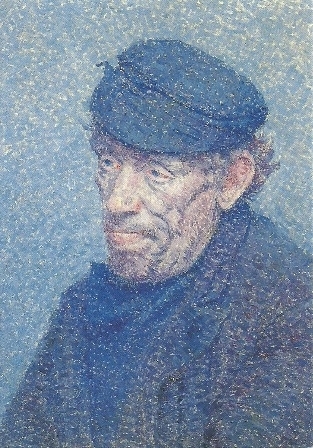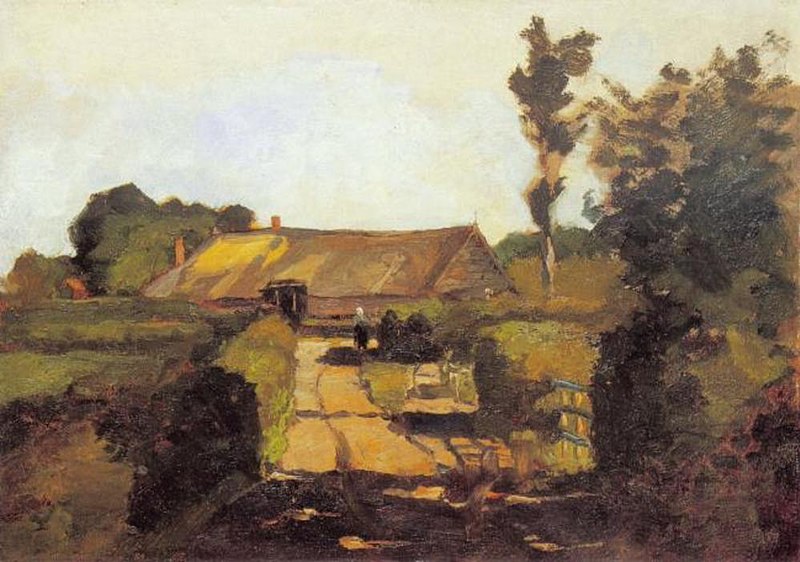From the mid-19th century, paint was available in tubes and this made it possible to paint outdoors; the environment mattered and applying the paint was faster (and less refined and precise) than in the previous period. After centuries of dominance of history painting, the Barbizon school led to a revaluation of the landscape. They were therefore important precursors of impressionism. It started around 1840 in Oosterbeek and the surrounding area, where painters such as Jozef lsraëls, Willem Roelofs and Johannes W. Bilders moved. In 1845 this became even easier with a railway line between Amsterdam and Arnhem. Curious about Bilders' stories, Willem Maris, Paul Gabriël and Anton Mauve also came to Oosterbeek. The forests with the large, wild and mysterious (Wodans) oaks were a popular subject. In a romantic style, their paintings showed the lush hilly landscape. These artists developed their own painting style, which was looser than the romantic work of Bilders and would later form the Hague School.

Jozef lsraëls Sewster 1880 Rijks
In 1870 it was (again) Joseph Israëls who was the first to visit Laren, partly for the beautiful meadow landscapes. Anton Mauve and Albert Neuhuys soon followed. Between 1875 and 1930, Laren (including neighboring Blaricum) became a popular place of residence for artists. In their style they worked according to the principles of naturalism and increasingly left romanticism behind them; the Larense School was born. They painted the heath, the sheepfold and farm life. In the decades that followed, Laren increasingly became the cradle of further innovation. After 1898, the "second generation" of the Larense School came to Het Gooi, including Jaap Dooijewaard and Ferdinand Hart Nibbrig. Most of them were genre painters, influenced by Neuhuys. And there were "landscape artists" such as Cornelis Vreedenburgh and David Schulman. Various painters of the second generation paint in the realistic tradition of the first generation. Others became increasingly impressionistic. Co Breman and Ferdinand Hart Nibbrig, for example, painted landscapes in pointillist and luminist style. The third generation was formed by modernists such as Piet Mondriaan, Jan Sluijters and Leo Gestel. Laren is therefore also at the beginning of the road to abstraction and modern art. Well-known foreign painters also visited Laren; Max Beckmann and Max Liebermann were regular visitors during his semi-hidden period during the war. Albert Neuhuys, Farming family in Laren
Albert Neuhuys, Farming family in Laren
Foreign sources usually make no distinction and talk about the "Dutch Barbizon" of Oosterbeek and the Hague School. With outdoor painting, this group(s) had really done something innovative in terms of technique or optics. The Larense School had especially countryside as a subject versus The Hague maritime Impressionism.
The multi-generational painters often met in the pub of (hotel) Hamdorff. Jan Hamdorff had a kind of pact in which he supported painters, provided cheap drinks, mediated and thus attracted customers for himself and the painters. He also organized semi-covered exhibitions. Hamdorff was a councilor of Laren for 25 years and later also an alderman and made Laren great, just like many painters. What also helped, to say the least, was the fact that art collectors such as Pierre Alexandre Regnault and the couple William and Anna Singer settled in Laren and purchased many works. The Singers settled in Laren in 1901 and built their villa De Wilde Zwanen, which is now part of Singer.
Laren became a meeting point for successful and pour painters, bohemians, do-gooders, philosophers and scientists. Laren was quite progressive at that time. People discussed alternatives to capitalist society, such as within the international brotherhood around Jacob van Rees. Laren still has a wealth of artists' houses and is depicted as a village in countless paintings, prints and drawings.

Artists in Laren
1880-1900 The Countryside as a subject and above all naturalistic
Hein Kever, Willem Steelink, Anton Mauve, Albert Neuhuys, Wally Moes en Arina Hugenholtz, Tony Offermans, Lopes de Leao Laguna, Manus van der Ven, Douwe Komter, Hendrik Valkenburg, Cornelis Vreedenburgh, David Schulman

1900-1910 Beginning of the impressionist innovation and pointillism
Derk Meelis, Jacob en Willem Dooijewaard, Jan Veth, Co Breman, G. Bosch Reitz, R.N. Roland Holst, Ferdinand Hart Nibbrig, Antoon Derkinderen, Gust van de Wall Perné, Otto Van Tussenbroek en Evert Pieters, Bernard de Hoog, Henk de Court Onderwater, André Broedelet, Salomon Garf, Franz Deutmann, Lammert van der Tonge, Bernard Pothast, Gerrit Willem van Blaaderen, Bernard Polfliet, Frans Langeveld en Ed van de Ven.

1910-1930: The development towards abstract art
Bart van der Leck, Jan Sluyters, Piet Mondriaan, Leo Gestel, Chris Beekman, Frits van den Berghe, Gustave de Smet en Herman Kruyder.

